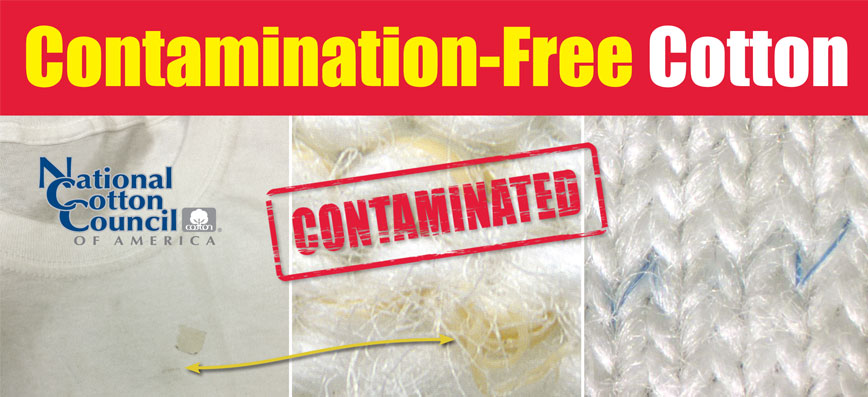
Keeping It Clean!
One of the National Cotton Council’s (NCC) foremost priorities is the continued delivery of contamination-free cotton to U.S. cotton customers in the global marketplace – a need more critical than ever because of fierce competition from other growths and man-made fibers. The NCC urges producers, ginners and other industry members to strive for “zero tolerance” when it comes to seed cotton and lint contamination. Following are links to resources aimed at helping industry members keep their cotton clean.
(NEW!) Round Module Wrap for Seed Cotton Certification and Standard
The Cotton Engineering Committee within the ASABE recently updated standard S615.2, titled “Cotton Module Cover Material Performance,” to include testing requirements and performance specifications for round module wrap. The goal of this updated standard is to define minimum performance levels for round module wrap products in order to protect stored seed cotton from quantity and quality losses and minimize plastic contamination in ginned lint bales. Sample preperation requirements are outlined in the Round Module Wrap for Seed Cotton Certification and Standard.
(NEW!) Round Module Wrap RFID ASABE Standard
The new version, ASABE S647.1 JAN2025ED, Seed Cotton Module Identification System, has been published and includes an update on RFID designations for manufacturers of round module wraps who have entered the marketplace since the original version of the standard was first published.
ASABE members with standards access and those with site-license privileges can access the full-text via electronic download on the ASABE online Technical Library at elibrary.asabe.org/. Others can obtain a download for a fee directly from the library or by contacting ASABE headquarters at OrderStandard@asabe.org.
(NEW!) Round Module Wrap Standard Flyer
Protecting the quality of our cotton is more important than ever! Producers are urged to only use approved wrap products, ensuring the chance for plastic contamination is greatly reduced.
Evaluation of Practices to Unwrap Round Cotton Modules
This work evaluates the well-known unwrapping systems used to handle modules in the U.S. and Australia, which include manual and semi-automated methods.
Tama Round Module Wrap- Blue Value
Recommendations and best handling practices for Tama Blue Value Round Module Wrap.
Prevention of Plastic Contamination When Handling Round Modules
This document provides growers, module handlers and ginners recommendations on handling round modules from the field to the gin with a goal of eliminating plastic contamination in U.S. cotton.
Plastic Contamination Prevention Seminar
Texas A&M Agrilife Extension Service hosted a Zoom seminar for South Texas producers and ginners to discuss the issue of plastic contamination. Several industry leaders also were involved in the discussions, which ranged from economic impacts, resources and best management practices, to classing office observations.
Best Management Practices for Contamination Prevention Video
The National Cotton Council urges producers, ginners and other industry members to make seed cotton/lint contamination prevention a high priority. To enhance this effort, the NCC developed and is distributing a comprehensive educational video focusing on plastic contamination prevention. Also available to view in Spanish.
Contamination Prevention Guidelines
U.S. cotton industry members are encouraged to follow these guidelines to help U.S. cotton maintain its reputation as a source of clean fiber. The NCC also has developed “Keep It Clean" posters. Producers and ginners are urged to download these posters and mailer and to display them prominently such as in farm offices, gin offices and on equipment. This step will help workers in recognizing and removing potential contaminating materials prior to harvest and during ginning.
The NCC also has received industry requests for photographs of plastics and other potential contaminants, such as those on these posters. So, the NCC urges producers and ginners with similar photographs to email them to keepitclean@cotton.org for use in future NCC educational materials.
Extraneous Matter Code for the 2018 Crop and Beyond
The USDA AMS Cotton and Tobacco Program (C&T) will implement two new extraneous matter codes for samples containing plastic contaminants. This change is being implemented beginning July 1, 2018 in response to industry requests and concerns.
Very Serious Matter
Cotton's Agenda story in August 3, 2017 edition of Cotton Farming. As the 2017 harvest and ginning season approaches, National Cotton Council President Gary Adams urges its members to continue giving top priority to lint contamination prevention.
Prevent Lint Contamination
This NCC publication also offers steps for preventing problems with materials that can contaminate seed cotton and lint and result in blemished finished goods.
Contamination Free Cotton: Keep It Clean and Pure
This PowerPoint presentation on contamination prevention has both English and Spanish narrations.
Bale Marker Evaluation Study
This Cotton Incorporated publication’s basic message to producers and ginners is -- any material described as permanent should not be used as a module or a bale marker.
Round Module Handling/Wrap Removal Poster
This online NCC poster, and its Spanish version, describe techniques for round module handling and wrap removal – a harvest-time practice that is presenting challenges to contamination-free seed cotton and lint. Requests for these 24”x18” posters may be sent to keepitclean@cotton.org. Challenges associated with round module handling also are addressed in John Deere's round module handling and ginning preparation recommendations: 1) Cotton Module Staging and Truck Requirement, 2) Round Cotton Module Ginning Recommendations, and 3) Deere Round Seed Cotton Module Ginning Recommendations. Likewise, The National Cotton Ginners Association’s 17-minute Round Module Safety training video includes a strong emphasis on contamination prevention.
Cotton Incorporated Publications
Cotton Incorporated has a number of cotton harvest systems documents that focus on minimizing contamination while maximizing harvesting and ginning efficiency.
Cotton Contamination Incident Report
The NCC, Cotton Council International (the NCC's export promotions arm), and the National Council of Textile Organizations are asking cooperating mills and others –- the most reliable information sources -- to share (confidentially) their cotton contamination incidents. This verification is invaluable to U.S. cotton's zero contamination goal.

